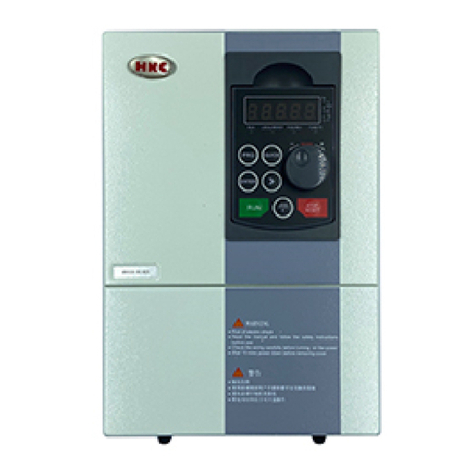
HV100 Series High Performance Current Vector Inverter
1
Contents
Contents........................................................................................................................................................................1
Chapter I Safety Information.................................................................................................................................... 3
1.1 Marks and definitions of safety information....................................................................................3
1.2 Use range.....................................................................................................................................................3
1.3 Installation Environment........................................................................................................................ 3
1.4 Installation safety matters......................................................................................................................4
1.5 Use safety matters.................................................................................................................................... 5
Chapter II Standard Specifications of Products...................................................................................................6
2.1 Technical specifications.........................................................................................................................6
2.2 Inverter model description.....................................................................................................................9
2.3 Size of chassis and keyboard...............................................................................................................9
2.4 Rated current output meter................................................................................................................. 11
2.5 Selection of Braking Resistance Table........................................................................................... 11
Chapter III Storage and Installation......................................................................................................................13
3.1 Storage....................................................................................................................................................... 13
3.2 Installation site and environment......................................................................................................13
3.3 Installation space and direction........................................................................................................ 13
Chapter IV Wiring..................................................................................................................................................... 14
4.1 Main circuit wiring diagram.................................................................................................................14
4.2 Connecting terminal Figure.................................................................................................................14
4.2.1 The function description of the main circuit terminal is as follows:.................................... 14
4.2.2 The terminal for controlling loop.................................................................................................15
4.2.3 Jumper settings of main control board..................................................................................... 16
4.3 Basic wiring diagram.............................................................................................................................16
4.4 Matters needing attention for Wiring............................................................................................... 18
4.4.1 Main circuit wiring..........................................................................................................................17
4.4.2 Control circuit wiring (signal line)...............................................................................................18
4.4.3 Grounding wire...............................................................................................................................19
4.5 Matters needing attention for specific application......................................................................18
4.5.1 Type selection................................................................................................................................ 19
4.5.2 Matters needing attention in motor use....................................................................................19
Chapter V Operation and display..........................................................................................................................20
5.1 keypad description.................................................................................................................................... 20
5.1.1 Diagram of keypad........................................................................................................................20
5.1.2 Key Description..............................................................................................................................20
5.1.3 Description of function indicator lamp.......................................................................................20
5.2 Operation process..................................................................................................................................21
5.21 Parameter setting........................................................................................................................... 21
5.2.2 Fault reset....................................................................................................................................... 21
5.2.3 Self-learning of motor parameters.............................................................................................21
Chapter VI Functions and Parameter Table.......................................................................................................22
Chapter VIII EMC (Electromagnetic Compatibility)...........................................................................................60
8.1 Definitions...............................................................................................................................................129
8.2 Introduction to EMC Standards....................................................................................................... 126





























